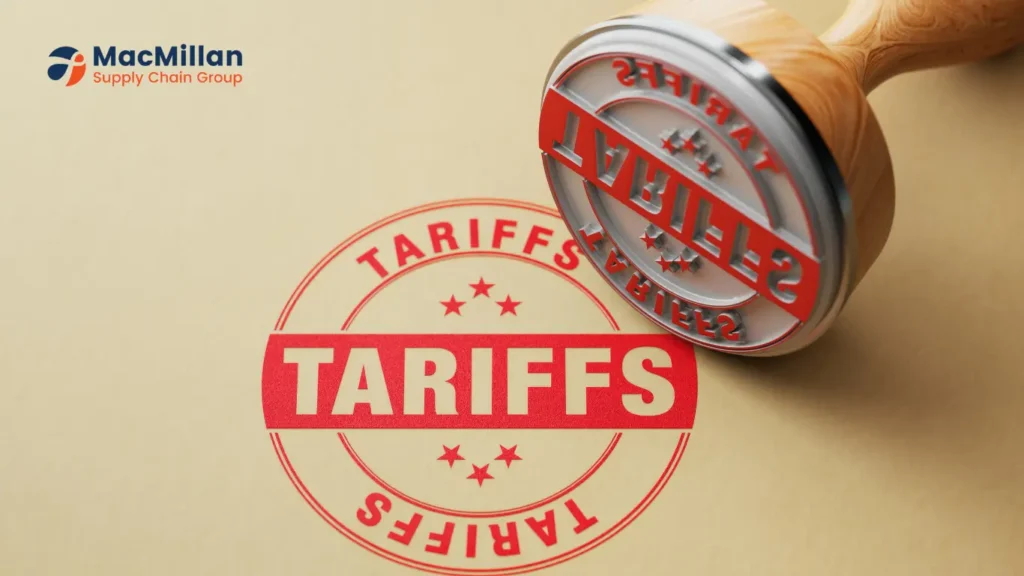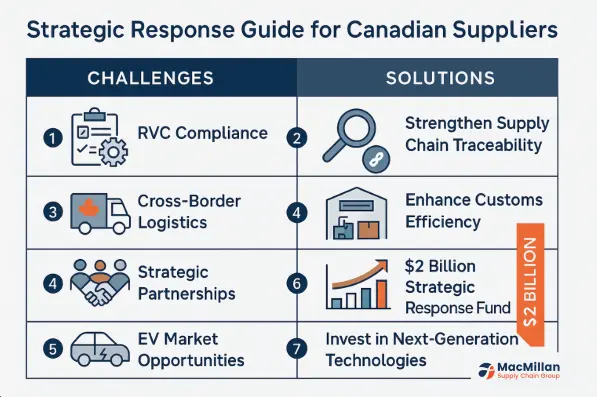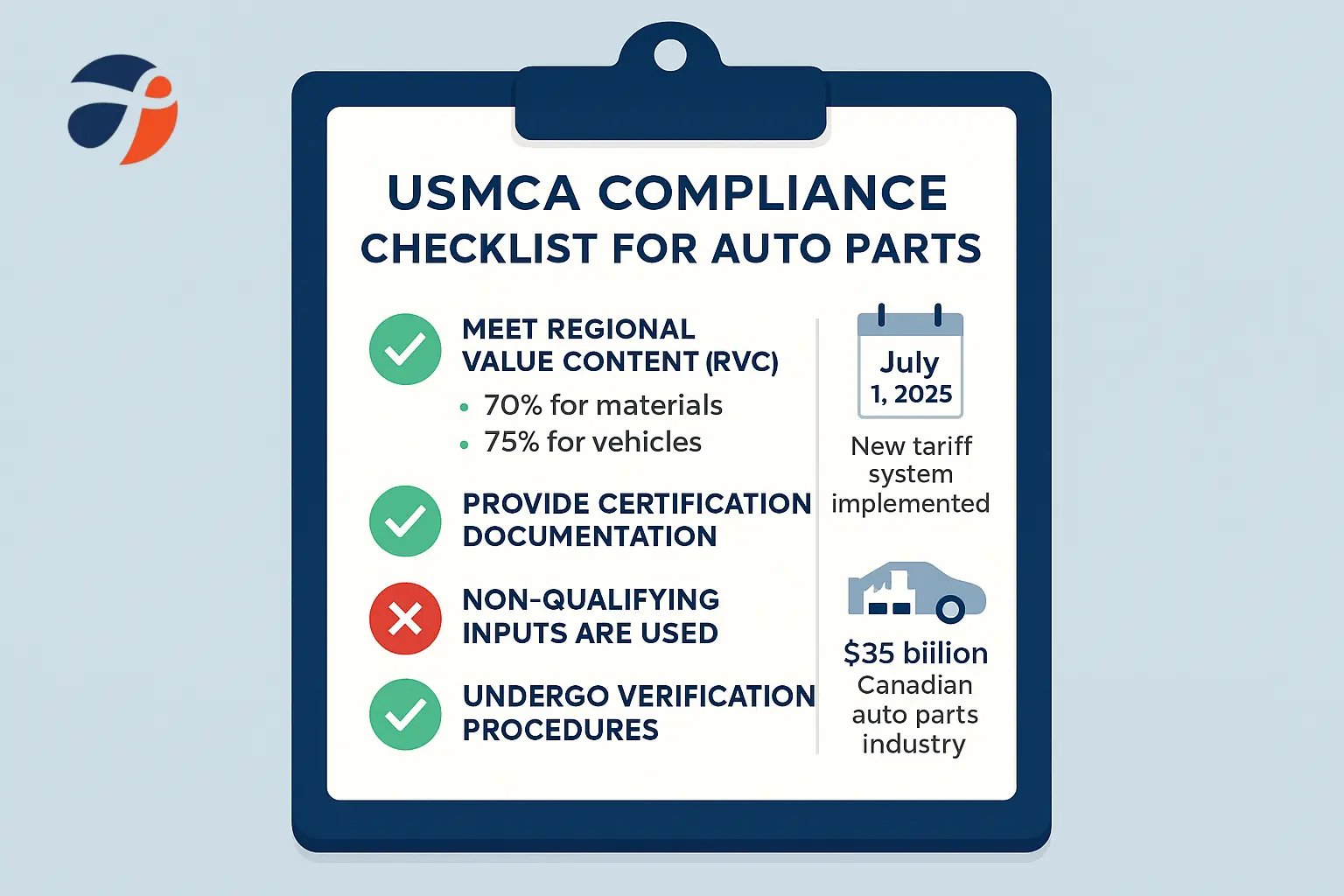Automakers that use US/USMCA parts in US-assembled vehicles can receive rebates thanks to recent tariff adjustments made by President Donald Trump. Despite being intended to increase American manufacturing, these modifications pose serious difficulties for Canadian auto suppliers. For cars with 85% or more USMCA-compliant parts, the new system offers a 3.75% rebate in year one and a 2.5% rebate in year two. Non-compliant parts are subject to 25% tariffs. North American automotive supply chains are changing as a result of this policy change, and Canadian suppliers may lose contracts, experience cross-border issues, and see a decrease in exports. Through regional partnerships, EV market diversification, and RVC certification, Canadian auto suppliers can overcome these obstacles with strategic adaptation.
Introduction
The automotive industry across North America is experiencing a major shift following President Donald Trump’s executive order on tariffs. In April 2025, the administration introduced a system of rebates and penalties designed to incentivize US-assembled vehicles using parts from USMCA countries (United States, Mexico, and Canada).
The integrated North American auto industry faces both opportunities and challenges as a result of this new strategy. The policy has repercussions across the supply chain, especially for Canadian auto suppliers who have historically been closely linked to US production, even though its goal is to boost domestic manufacturing in the US.
These developments necessitate prompt attention and careful planning from Canadian auto suppliers. In addition to knowing how these tariff adjustments work, businesses also need to know how to best position themselves to stay competitive in this changing market. Let’s examine the implications of these modifications and how Canadian auto suppliers can adjust to this new situation.
Understanding the New Tariff Structure for Canadian Auto Suppliers
The Trump administration’s new tariff structure gives the automobile industry a carrot-and-stick strategy. For Canadian auto suppliers trying to negotiate this shifting environment, it is essential to comprehend these mechanics.
A sliding scale governs the rebate structure. If at least 85% of the parts in a vehicle meet US/USMCA content requirements, automakers can get a 3.75% rebate of the vehicle’s MSRP between April 2025 and April 2026. This rebate drops to 2.5% the following year (May 2026–April 2027), which puts pressure on manufacturers to make quick adjustments. On the other hand, significant 25% tariffs on parts that don’t meet USMCA thresholds are imposed on non-compliant imports.
Companies that prioritize domestic or USMCA-certified components, such as Ford and GM, are purposefully rewarded by this system. For instance, if a $40,000 car satisfies the regional content requirements, it may be eligible for a $1,500 rebate in the first year. Automakers are therefore financially motivated to carefully examine their supply chains and give preference to vendors who can assist them in reaching these benchmarks.
Through the USMCA framework, the policy seeks to expedite the reshoring of vital automotive manufacturing while preserving a certain amount of flexibility. This implies that it is now more crucial than ever for Canadian auto suppliers to comprehend precisely how their parts fit into an automaker’s regional value content calculations.
Immediate Challenges Faced by Canadian Auto Suppliers
As these tariff changes go into effect, Canadian auto suppliers will face a number of immediate challenges. The biggest worry is that contracts may be lost as US automakers reevaluate their supplier relationships in an effort to increase their eligibility for rebates.
Many Ontario-based producers of engines, transmissions, and other vital parts run the risk of being shut out if their goods don’t adhere to USMCA compliance requirements. Automakers might switch to Mexican or American suppliers who can assist them in meeting the 85% rebate threshold. Small and medium-sized businesses (SMEs), which lack the resources to swiftly modify their production processes, should be especially concerned about this.
Another major obstacle is the complexity of cross-border supply chains. For many years, the automotive sector has used integrated production networks, in which components travel across borders several times while being manufactured. Each border crossing for non-compliant parts may result in additional expenses under the new tariff regime. For example, Canadian raw materials that are processed in the United States, put together in Mexico, and then brought back to the United States for the last stage of vehicle assembly may be subject to compounded tariffs at every stage.
Another level of complexity is introduced by Canada’s retaliatory actions. EVs and high-end cars that did not comply with the USMCA were subject to matching 25% duties levied by the Canadian government. Despite being designed to safeguard domestic production, these countermeasures may further upset long-standing supply chains and limit Canadian auto suppliers’ access to the global market.
 Strategic Responses from Automakers and the Canadian Government
Strategic Responses from Automakers and the Canadian Government
In reaction to these tariff changes, major automakers are quickly changing their strategies. US-made parts are being given priority by Ford and General Motors, especially for expensive products like batteries, electric motors, and semiconductors. The goal of this reshoring initiative is to reach regional value content (RVC) requirements in order to be eligible for the available rebates.
While they reevaluate their cost structures and supply chains, some manufacturers have even delayed providing investors with financial guidance. To illustrate the substantial influence these changes are having on business planning, GM, for example, postponed its earnings forecast to account for possible tariff-related expenses.
Particular difficulties arise for Asian manufacturers who have production facilities in Canada. Honda’s Civic and Toyota’s RAV4, which are both built in Ontario, may lose market share in the US unless they greatly expand their USMCA-compliant content. Their Canadian auto suppliers are under pressure to either comply with compliance requirements or risk losing business as a result.
In order to assist the automotive industry in adapting, the Canadian government has set up a $2 billion Strategic Response Fund. This fund helps with workforce training, technology advancements, and plant retooling. Industry analysts, however, wonder if this sum will be enough to handle the magnitude of change required, particularly to support the shift to electric vehicle manufacturing.
The Canadian government’s retaliatory tariffs represent another strategic response, designed to protect domestic production while encouraging negotiations. However, this approach risks escalating trade tensions and creating additional uncertainty for Canadian auto suppliers caught in the middle.
Common Problems Impacting Canadian Auto Suppliers
The automotive supply chain faces a number of structural issues as a result of the new tariff policies’ implementation:
Compliance Verification Challenges: Due to complicated auditing requirements and paperwork burdens, many Canadian auto suppliers find it difficult to document and verify their RVC compliance.
Supply Chain Disruption: Rapid restructuring of decades-old supply chains may result in inefficiencies and part shortages.
Investment Uncertainty: Companies are reluctant to make long-term investments if they are uncertain about the stability of tariff policies, particularly in the context of changing political administrations.
Disproportionate Impact on SMEs: Due to their inability to quickly alter production or relocate facilities, smaller Canadian auto suppliers are more susceptible than larger companies.
Cross-Border Logistics Complications: With more paperwork needed and possible delays, the new tariff structure makes handling cross-border shipments more difficult.
Market Access Reduction: The US market, which has historically been the biggest export destination for Canadian auto suppliers, may become less accessible.
Competitive Disadvantage: As the cost of vehicles manufactured in North America rises, Chinese and other foreign producers may increase their market share in Canada.
MacMillan’s Supply Chain Solutions for Canadian Auto Suppliers
We at MacMillan Supply Chain Group are aware of the difficulties facing Canadian auto suppliers in this dynamic trade landscape. Our all-encompassing strategy aids businesses in navigating these challenges while preserving their competitiveness.
Optimization of the Supply Chain for RVC Compliance
In order to find RVC compliance gaps, we assist Canadian auto suppliers in analyzing their present supply chains. Our team collaborates with you to create plans that optimize regional content and cut expenses.
Identifying cross-border touchpoints through thorough supply chain mapping
Suggesting substitute sourcing choices in USMCA areas
Creating documentation systems that expedite the verification of compliance
Management of Cross-Border Logistics
Our knowledge of international shipping helps cut down on delays and tariff exposure. We provide:
Consolidated shipping options that lower the frequency of border crossings
Preparing advanced customs documentation to avoid delays in clearance
Positioning inventory strategically to reduce the impact of tariffs on just-in-time delivery
Solutions for Strategic Warehousing
As Canadian auto suppliers adjust to new trade realities, our warehousing facilities in strategic locations across Canada help them stay responsive to the market:
Despite shifting logistics patterns, buffer inventory management ensures a steady supply
Distribution centers are positioned strategically to reduce cross-border movements
Adaptable storage options to meet your evolving needs
Support for Supply Chain Diversification
Beyond conventional automotive channels, we assist Canadian auto suppliers in exploring new markets and opportunities:
Analyzing the market to find new prospects in the EV and alternative mobility sectors
Distribution network design for breaking into new market segments
Logistics planning for new client relationships in Mexico and other USMCA regions
Services for Compliance Documentation
Our group assists in streamlining the intricate documentation needed for USMCA compliance:
Standardized documentation procedures for RVC certification are being developed
Your team will receive training on compliance requirements
Help with audit preparation to make sure you’re prepared for formal validation
Incorporating Technology to Increase Supply Chain Visibility
We put into practice digital solutions that give Canadian auto suppliers complete supply chain visibility:
Real-time cross-border shipment tracking
Automated records of compliance
Using predictive analytics to find possible disruption risks before they affect output
Canadian auto suppliers can turn these tariff obstacles into chances for increased productivity and market expansion by collaborating with MacMillan Supply Chain Group. In this changing trade environment, our integrated approach takes into account both short-term tactical requirements and long-term strategic positioning.
 How Canadian Auto Suppliers Can Implement These Solutions
How Canadian Auto Suppliers Can Implement These Solutions
There are a few doable actions you can take to safeguard your company and set yourself up for future success if you’re a Canadian auto supplier who is having trouble because of these tariff changes.
Begin by thoroughly evaluating your present level of RVC compliance. This entails examining your bill of materials to ascertain the precise proportion of components that come from USMCA nations. Knowing your baseline will help you pinpoint areas that need improvement in order to add more regional content.
Investigate strategic alliances with additional USMCA suppliers after that. You can develop integrated supply solutions that assist OEMs in reaching their compliance goals by partnering with complementary companies in the US or Mexico. This strategy frequently turns out to be more economical than trying to move production facilities.
Think about branching out into new automotive markets, especially those for electric cars and driverless technology. These expanding markets frequently have distinct supply chain architectures and could present chances to build new clientele that are less impacted by conventional tariff issues.
Invest in supply chain technology that offers more control and visibility. Blockchain verification, automated documentation, and digital tracking systems can all greatly lessen the administrative load of compliance while enhancing your ability to adapt to evolving regulations.
Don’t overlook government support programs. Funding for workforce development and retooling can be obtained through the Strategic Response Fund and other programs. You can more easily access these resources by collaborating with industry associations.
Think about collaborating with MacMillan Supply Chain Group for all-encompassing assistance in overcoming these obstacles. Our knowledge of supply chain optimization, warehousing, and cross-border logistics can help Canadian auto suppliers stay competitive as they adjust to the new tariff environment. Get in touch with us right now to find out how our customized solutions can meet your unique requirements in this dynamic environment.
You can set up your company to not only withstand these tariff changes but also prosper in the newly reformed North American auto industry by acting proactively now.
FAQS
The new tariff system offers rebates to automakers who use US/USMCA-compliant parts in US-assembled vehicles. In the first year (April 2025-April 2026), manufacturers can receive a 3.75% rebate if 85% or more of a vehicle's parts meet regional content requirements. This drops to 2.5% in the second year. Non-compliant parts face a 25% tariff. This system rewards domestic production while penalizing imports that don't meet USMCA thresholds.
Your parts meet USMCA compliance if they satisfy the Regional Value Content (RVC) requirements, which typically range from 60-75% depending on the specific component. To determine compliance, you need to track the origin of all materials and processing costs. This requires detailed documentation of your supply chain, including certificates of origin from your suppliers. Professional certification services can help verify your compliance status.
Canada has imposed matching 25% tariffs on non-USMCA-compliant US vehicles, including electric vehicles and luxury cars. These countermeasures aim to protect Canadian production and encourage negotiations. However, they also create additional market complications, potentially reducing overall trade volume and creating price increases for Canadian consumers. The retaliatory measures primarily affect finished vehicles rather than parts.
Small suppliers should focus on niche specialization in high-value components where they have unique expertise. Consider joining industry consortiums to share compliance costs and resources. Leverage government support programs specifically designed for SMEs. Explore partnerships with larger USMCA-compliant manufacturers who can incorporate your components into their certified assemblies. Digital tools can also help streamline compliance documentation without requiring large investments.
The EV transition offers significant opportunities despite tariff challenges. Focus on battery materials, charging infrastructure components, lightweight materials, and thermal management systems. Canada's abundant natural resources position suppliers well for battery supply chains. Government incentives for clean technology can support transition costs. Consider partnerships with emerging EV manufacturers who are establishing new supply chains less entrenched in traditional networks.
We expect to see more regionalized supply chains with fewer border crossings during production. Companies will likely consolidate manufacturing within single countries where possible. Just-in-time delivery systems may shift toward more buffer inventory to manage border uncertainties. Digital tracking and documentation will become essential for managing compliance. Some suppliers may establish parallel production facilities on both sides of borders to maintain flexibility.
Resources include Canada's $2 billion Strategic Response Fund for retooling and workforce development. Industry associations like the Automotive Parts Manufacturers' Association offer compliance guidance and advocacy. Export Development Canada provides financing for supply chain adjustments. Provincial programs in Ontario and Quebec offer additional support. MacMillan Supply Chain Group provides logistics and supply chain consulting specifically tailored to these challenges.
Chinese EV manufacturers may gain market share in Canada as US-made vehicles become more expensive due to tariff complications. They might establish assembly operations in Mexico to access USMCA benefits. Some Chinese companies are exploring partnerships with Canadian suppliers to create compliant supply chains. This creates both competitive threats and potential new customer opportunities for Canadian parts manufacturers.
The most effective strategies include achieving and documenting RVC compliance, forming strategic partnerships with US manufacturers, establishing US production facilities for critical components, developing unique technological advantages that make your products essential regardless of tariff costs, and creating flexible logistics systems that can adapt to changing trade rules.
MacMillan Supply Chain Group offers comprehensive solutions including supply chain mapping to identify compliance gaps, cross-border logistics optimization to minimize tariff exposure, strategic warehousing to maintain market responsiveness, compliance documentation services to simplify paperwork requirements, and consulting on supply chain diversification. Our expertise in Canadian-US trade logistics makes us an ideal partner for automotive suppliers adapting to these new tariff realities. Contact us today to discuss your specific challenges and how we can help you transform them into competitive advantages.

 Strategic Responses from Automakers and the Canadian Government
Strategic Responses from Automakers and the Canadian Government How Canadian Auto Suppliers Can Implement These Solutions
How Canadian Auto Suppliers Can Implement These Solutions


